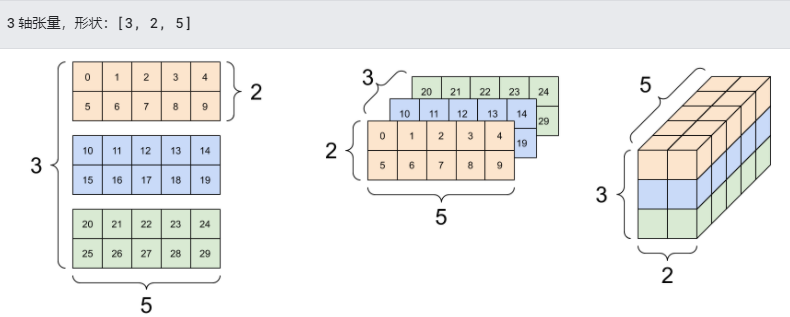【TensorFlow】笔记:基本操作-张量操作(一)
深度学习入门笔记
共 2186字,需浏览 5分钟
·
2021-01-26 16:36
TensorFlow 使用 张量 (Tensor)作为数据的基本单位。TensorFlow 的张量在概念上等同于多维数组,我们可以使用它来描述数学中的标量(0 维数组)、向量(1 维数组)、矩阵(2 维数组)等各种量。
基础知识
首先,我们导入tensorflow,
import tensorflow as tf我们来创建一些基本张量,
tensor1 = tf.constant(4)print(tensor1)# outputtf.Tensor(4, shape=(), dtype=int32)
这是一个“标量”(或称“0 秩”张量)。标量包含单个值,但没有“轴”。
tensor2 = tf.constant([2.0, 3.0, 4.0])print(tensor2)# outputtf.Tensor([2. 3. 4.], shape=(3,), dtype=float32)
这是一个“向量”(或称“1 秩”张量)就像一个值的列表。向量有 1 个轴。
tensor3 = tf.constant([[1, 2],[3, 4],[5, 6]], dtype=tf.float16)print(tensor3)# outputtf.Tensor([[1. 2.][3. 4.][5. 6.]], shape=(3, 2), dtype=float16)
这是一个“矩阵”(或称“2 秩”张量)有 2 个轴。
总结

张量的轴可能更多,下面是一个包含 3 个轴的张量:
tensor4 = tf.constant([[[0, 1, 2, 3, 4],[5, 6, 7, 8, 9]],[[10, 11, 12, 13, 14],[15, 16, 17, 18, 19]],[[20, 21, 22, 23, 24],[25, 26, 27, 28, 29]],])print(tensor4)# outputtf.Tensor([[[ 0 1 2 3 4][ 5 6 7 8 9]][[10 11 12 13 14][15 16 17 18 19]][[20 21 22 23 24][25 26 27 28 29]]], shape=(3, 2, 5), dtype=int32)

张量通常包含浮点型和整型数据,但是还有许多其他数据类型,包括:
复杂的数值
字符串
tf.Tensor 基类要求张量是“矩形”——也就是说,每个轴上的每一个元素大小相同。但是,张量有可以处理不同形状的特殊类型。
我们可以对张量执行基本数学运算,包括加法、逐元素乘法和矩阵乘法运算。
a = tf.constant([[1, 2],[3, 4]])b = tf.constant([[1, 1],[1, 1]])print(tf.add(a, b), "\n") # 对应元素相加print(tf.multiply(a, b), "\n") # 对应元素相乘print(tf.matmul(a, b), "\n") # 做矩阵乘法# outputtf.Tensor([[2 3][4 5]], shape=(2, 2), dtype=int32)tf.Tensor([[1 2][3 4]], shape=(2, 2), dtype=int32)tf.Tensor([[3 3][7 7]], shape=(2, 2), dtype=int32)
print(a + b, "\n") # element-wise additionprint(a * b, "\n") # element-wise multiplicationprint(a @ b, "\n") # matrix multiplication# outputtf.Tensor([[2 3][4 5]], shape=(2, 2), dtype=int32)tf.Tensor([[1 2][3 4]], shape=(2, 2), dtype=int32)tf.Tensor([[3 3][7 7]], shape=(2, 2), dtype=int32)
各种运算 (op) 都可以使用张量。
a = tf.constant([[4.0, 5.0], [10.0, 1.0]])# 找最大值print(tf.reduce_max(a))# 找最大值的索引print(tf.argmax(a))# outputtf.Tensor(10.0, shape=(), dtype=float32)tf.Tensor([1 0], shape=(2,), dtype=int64)

点击上方“蓝字”关注本公众号
点击上方“蓝字”关注本公众号
评论
